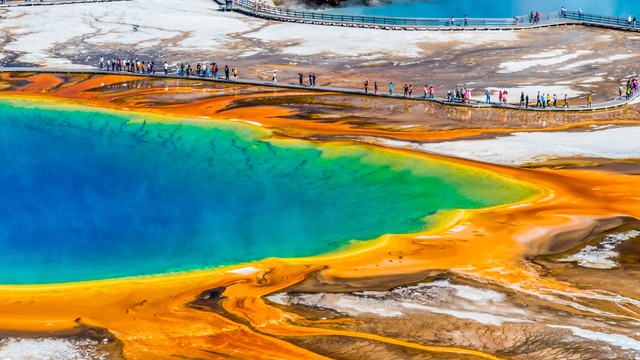What’s the climate like in Utah?
The current climate in Utah features temperatures ranging from a high of 33°C to a low of 3°C throughout the year. The average yearly temperature is around 18°C. At night, temperatures in the colder months average around -8°C and in the warmer months around 17°C.
The highest temperature recorded in Utah in recent years was 39°C in July 2021. The lowest daytime temperature recorded was -8°C in January 2017.
On average, Utah gets 223 mm of precipitation each year. Of this, about 160 cm is snowfall. For comparison, New York gets 1142 mm of precipitation each year.
The climate in Utah is based on weather data from . Other places, like New York City, Miami or Los Angeles, might have different weather. You can check out all destinations in Utah to get the full picture of the climate.
Best time to visit Utah?
The best time to visit Utah for sunny weather is May through October. During this period, you'll have nice temperatures and not too much rain, making it a great time to visit Utah. In the other months of the year, there's too much rain or the temperature isn't ideal for a visit if you want sunny and pleasant weather.
Climate Table of Utah
The climate table of Utah shows the average temperatures, rainfall, snow, and UV index per month. The table provides an overview of the average day and night temperatures in degrees Celsius, the total amount of rainfall in millimeters, the total snowfall in centimeters, and the UV index for each month. Rainfall is always measured as water, even if it's snow or hail.
| Jan | Feb | Mar | Apr | May | Jun | Jul | Aug | Sep | Oct | Nov | Dec | |
|---|---|---|---|---|---|---|---|---|---|---|---|---|
| Temp. max (°C) | 3 | 6 | 11 | 17 | 22 | 30 | 33 | 31 | 27 | 18 | 10 | 3 |
| Temp. min (°C) | -8 | -5 | -1 | 3 | 8 | 14 | 17 | 16 | 12 | 4 | -2 | -7 |
| Precipitation | ||||||||||||
| Precipitation (mm) | 20 | 13 | 29 | 12 | 17 | 15 | 12 | 31 | 27 | 19 | 13 | 15 |
| Snow (cm) | 35 | 33 | 32 | 2,9 | 0,8 | 0 | 0 | 0 | 0 | 1,6 | 19 | 35 |
| UV Index | 5 | 6 | 7 | 8 | 9 | 10 | 9 | 9 | 8 | 6 | 5 | 4 |
Click on the month name to see more weather details, like daily averages, temperatures, and precipitation for the past years in that month.
- Average yearly temperature: 18°C
- Highest temperature: 33°C in July
- Lowest temperature: 3°C in January and December
- Precipitation*: 223 mm per year, averaging 19 mm per month
- Snowfall: 160 cm per year
- Driest months: 12 mm in April, July and 13 mm in February
- Wettest months: 31 mm in August, 29 mm in March and 27 mm in September
*Precipitation is measured as a combination of rain, snow, and hail
Weather experiences in Utah
Average Temperature per Month in Utah
This graph shows the average maximum temperatures per month in Utah, United States. The temperatures are shown in degrees Celsius and the average is calculated based on the recorded temperatures per month from past years.
Average Precipitation per Month in Utah
This graph shows how much rainfall Utah, United States, gets on average per month. Rainfall is always measured as water, even if it's snow or hail. This makes it easy to compare how much has fallen, regardless of the form of precipitation. The amount of rainfall is measured in millimeters, and the average is calculated based on the recorded rainfall per month from past years.
Average Snowfall per Month in Utah
This graph shows how much snow Utah, United States, gets on average per month. The amount of snowfall is measured in centimeters and the average is calculated based on the recorded snowfall per month from past years.
Average UV Index per Month in Utah
This graph shows the average UV index per month in Utah, United States. The UV index indicates the intensity of ultraviolet radiation and ranges from 0 to a maximum of 11.
Yearly Temperature in Utah
This graph shows the average yearly temperature in Utah, United States. The yearly temperature, expressed in degrees Celsius, is the average of all twelve monthly temperatures summed up for that year.
Total Yearly Precipitation in Utah
This chart shows the total yearly precipitation in Utah, United States, over the past few years. The total yearly precipitation, measured in millimeters, is the sum of all the rain that fell in the twelve months of that year.
Total Yearly Snowfall in Utah
This chart shows the total yearly snowfall in Utah, United States, over the past few years. The total yearly snowfall, measured in centimeters, is the sum of all the snow that fell in the twelve months of that year.
Weather experiences in Utah
The weather in Utah is rated an average of 4,5 out of 5 stars by 2 visitors. Have you been to Utah? Share your weather experience to help other visitors.
Write your own reviewTight blue and sunny weather, but also really cold. Between 0 and 14 degrees during the day. Super nice for hiking (which you can do a lot). Evenings and nights are cold, regularly -2 for example. Do bring a good jacket.— This text is automatically translated to English
Lovely sunny weather about 30 degrees Celsius— This text is automatically translated to English
Have you been to Utah?
Share your weather experiences in Utah.
Average weather in Utah by month
Click on a month below to see detailed weather info for Utah. Based on historical weather data, you can see the average temperature, precipitation, wind, and UV index for each day of the month.
Popular destinations in United States
Discover the climate of these popular destinations in United States.












